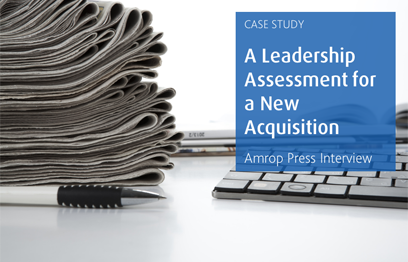Strategic Leadership Assessment in a New Acquisition Process: A Case Study
Polaris takes a majority stake in software company Configit, Amrop supports with strategic Leadership Assessment.

The Context
In February 2016, Polaris Private Equity (”Polaris”) announced that it had acquired 65% of the shares in the Danish software company Configit A/S: “The company has tripled its revenue in the recent three-year period, and Polaris aims to continue Configit’s current growth and globalisation.
The company’s former owners – IT and telecom entrepreneur Michael Moesgaard Andersen and Configit’s founders, CEO Henrik Reif Andersen and Chief Technical Officer Henrik Hulgaard – will continue as co-owners. Henrik Reif Andersen will also continue as the company’s CEO.
Configit is a leading global supplier of business-critical software solutions for configuration of complex products manufactured in a wide range of variants, for instance vehicles. Configit’s client list includes, among others, Jaguar Land Rover, MAN Truck & Bus, Fiat, Case New Holland and John Deere.
Additionally, other organisations involved in complex industrial equipment, for instance ABB, Siemens, Phillips and Vestas, use Configit’s configuration software from design, manufacturing and sales to maintenance of products. Configit has 140 clients, and 95% of revenue is generated outside of Denmark.” (Source, Configit).
Henrik Elsig Andersen, Leader of Amrop’s Global Leadership Services Practice, talked to Finance Monthly Magazine in the UK, about the Leadership Assessment objectives and process. The following is an extract.
Transaction Report
Polaris appointed Amrop Denmark to conduct a Leadership Assessment of the senior leaders in the company, in order to identify business critical individuals and positions, ensure motivation and engagement, and understand the strongholds and development areas.
Configit is Polaris’ first investment in a software company. Polaris has a clear goal of investing in more software and technology companies and has therefore established an internal team with this specific focus as well as an “ecosystem” of industrial advisers.
Please tell me about your involvement in this deal?
Polaris appointed Amrop to conduct a Leadership Assessment of the senior leaders in the company. There are a number of purposes related to such an assessment. One purpose relates to the need to quickly identify business critical individuals and positions as well as ensure they are motivated and engaged going forward. Another purpose is to understand the strongholds and development areas. This knowledge is crucial in terms of identifying areas which need to be developed internally or when external recruitment is required. Thirdly, a Leadership Assessment process often uncovers more overall organisational aspects, which can be improved. Finally, the process provides the new owners with a solid understanding of how to interact in the best possible way with the existing management team.
What is the normal content of a Leadership Assessment process?
We always start the process by looking into the investment case prepared and the related strategic challenges and use this to identify the critical leadership competencies. The competencies are unique from case to case, but when they have been identified, we tailor the assessment process to fit these. Most often leaders would go through two separate face-to face interviews, one focussing on the strategic, commercial and functional competencies and the other on the personal and social competencies.
We supplement the interviews with personality testing, ability testing and a strategic exercise. Once this is done, we invest much effort in providing the participants with clear feedback in terms of their strongholds and development areas and also brief the client on these issues. Generally, the client is briefed on three dimensions; an individual dimension focussing on the individual leader, a team dimension focussing on how the leadership team functions, and finally a third looking at our results from an organisational level.
What is the kind of feedback you get from leaders who have been through the process?
The best feedback we get, relates to the process being challenging, but also inspiring. A Leadership Assessment process is intense and leaders are taken out of their comfort zone; thus becoming challenging for some. However, if they are not up to this challenge, they are probably not ready for a private equity ownership. Also, as we always ensure that the participant is provided with feedback related to development areas, this is for almost all participants an inspiring element.
How often are you allowed to assess the leaders prior to the acquisition?
We are not always able to do this, but there is a growing acceptance and understanding of the importance of providing potential buyers with objective and nuanced input on the leadership capacity. More and more buyers consider this to be as important as more traditional parts of the due diligence phase, and we also see that the selling company perceives the request for Leadership Assessment as not only reasonable, but also as an indication of professionalism from the buyer’s side.
Do you experience a growing interest in Leadership Assessment as part of M&A processes?
We definitively do. There is an increasing acceptance and understanding of the value of getting a thorough and objective assessment of leaders and management teams, and that this is a crucial element when preparing the 100 day plan, as well as adjusting the initial investment case. Our contribution helps speeding up the process of creating the best possible leadership team, which leads to a minimal loss in business momentum. The equity clock is ticking from day one, and conducting a Leadership Assessment will have a direct impact on the return on equity.
Read the original article here.

